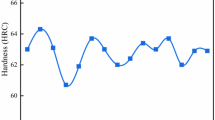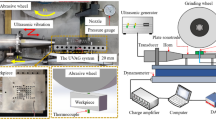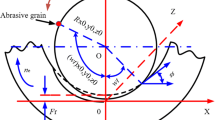Abstract
Among many machining methods, grinding is the most applicable one for cutting hard-to-cut materials such as superalloys. In this research, effects of longitudinal ultrasonic vibration of workpiece (Inconel738LC) in dry creep-feed up-grinding process were investigated. Mechanism of abrasive grain and workpiece surface interaction and the consequences have been analyzed both analytically and numerically. Then, the results have been compared with experimental findings. Analytical calculations showed that there is a multiple and discontinuous cutting along the contact zone of grinding wheel and the workpiece when longitudinal ultrasonic vibration is used. Two-dimensional finite element modeling in commercial MSC.Superform software, showed the same behavior and results. Grinding forces are one of the major output parameters for evaluations. It was observed that, application of ultrasonic vibration can decrease grinding forces. A practical decrease of up to 27% of vertical grinding forces and up to 22% of horizontal grinding forces has been achieved when using ultrasonic vibration. Finite-Element analysis has shown a reduction of about 40% of grinding forces compared with ordinary grinding. Probable lower risks of thermal damage even for working under dry conditions can be a big advantage of using ultrasonic with grinding.












Similar content being viewed by others
Abbreviations
- symbol (unit):
-
definition
- r (mm):
-
Grinding wheel radius
- a (μm):
-
Depth of cut
- l c (mm):
-
Grinding wheel and workpiece contact length
- \( {l_c}\prime \) (mm):
-
Grinding wheel and workpiece approximated contact length
- α (rad):
-
Central angle of grinding wheel and workpiece contact arc
- \( \alpha \prime \) (rad):
-
Slope angle of approximated contact length
- v s (m/s):
-
Grinding wheel peripheral velocity
- v sx (m/s):
-
Cutting grain horizontal velocity
- v sy (m/s):
-
Cutting grain vertical velocity
- v w (mm/min):
-
Workpiece feed speed
- v f (mm/s):
-
Cutting grain feed speed
- v us (mm/s):
-
Ultrasonic vibration speed
- v x,grain (mm/s):
-
Cutting grain horizontal relative speed
- v y,grain (mm/s):
-
Cutting grain vertical relative speed
- u x,grain (mm):
-
Cutting grain horizontal relative displacement
- u y,grain (mm):
-
Cutting grain vertical relative displacement
- u us (μm):
-
Ultrasonic vibration displacement
- \( \omega \prime \) (rad/s):
-
Grinding wheel angular speed
- ω (rad/s):
-
Vibration angular frequency
- f (kHz):
-
Vibration frequency
- u max (μm):
-
Vibration amplitude
- t (s):
-
Time
- \( t\prime \) (s):
-
Cutting grain displacement time along cutting arc
- F x (N):
-
Horizontal grinding force
- F y (N):
-
Vertical grinding force
- θ OG (rad):
-
Penetration angle of a grain into workpiece in ordinary grinding
- θ UAG,in (rad):
-
Penetration angle of a grain into workpiece in ultrasonic assisted grinding
- θ UAG,out (rad):
-
Exit angle of a grain from workpiece in ultrasonic assisted grinding
- μ (-):
-
Friction coefficient
- υ (-):
-
Poisson ratio
- ρ (gr/cm 3):
-
density
- E (GPa):
-
Elasticity modulus
References
Haddad MJ, Sadeghi MH, Tawakoli T (2009) An experimental investigation of the effects of workpiece and grinding parameters on minimum quantity lubrication—MQL grinding. Int J Mach Tool Manu 49:924–932
Tawakoli T, Rabiey M (2007) Dry grinding by special conditioning. Int J Adv Manuf Tech 33:419–424
Mult HC (1996) Ultrasonic assisted grinding of ceramics. J Mater Process Tech 62:287–293
Tawakoli T, Azarhoushang B (2008) Influence of ultrasonic vibrations on dry grinding of soft steel. Int J Mach Tool Manu 48:1585–1591
Pei ZJ, Prabhakar D, Ferreira PM (1995) A mechanistic approach to the prediction of material removal rates in rotary ultrasonic machining. J Eng Ind—T ASME 117:142–151
Wu YB (2004) Modeling of grinding force in constant-depth-of-cut ultrasonically assisted grinding. Mater Sci Forum 471–472:101–106
Wu Y, Zhao B (2006) Modeling of material removal in workpiece lateral ultrasonic vibration grinding of fine crystalline zirconia ceramics. Key Eng Mater 315–316:304–308
Malkin S (1968) The attrition and fracture wear of grinding wheels. Dissertation, Massachusetts Institute of Technology
Doman DA, Warkentin A, Bauer R (2009) Element modeling approaches in grinding. Int J Mach Tool Manu 49:109–116
Ohbuchi Y, Obikawa T (2003) Finite element modeling of chip formation in the domain of negative rake angle cutting. J Eng Mater-T ASME 125:324–332
Farhadi A (2010) Ultrasonic assisted creep feed grinding of inconel738LC. Dissertation, Isfahan University of Technology
MSC.Superform command reference (2005) MSC.Software Corporation, Santa Ana. http://www.cadfamily.com/
Sotoodehzadeh M (2008) Friction reduction in creep-feed grinding with ultrasonic lubrication. Dissertation, Amirkabir University of Technology
Miller HE, Chalmers WL (1970) Gas turbine design and superalloys. Wiley, New York
Ghosh S, Chattopadhyay AB, Paul S (2008) Modeling of specific energy requirement during high-efficiency deep grinding. Int J Mach Tool Manu 48:1242–1253
Malkin S (1989) Grinding technology: theory and application of machining with grinding wheels. Wiley, New York
Author information
Authors and Affiliations
Corresponding author
Rights and permissions
About this article
Cite this article
Abdullah, A., Farhadi, A. & Pak, A. Ultrasonic-Assisted Dry Creep-Feed Up-Grinding of Superalloy Inconel738LC. Exp Mech 52, 843–853 (2012). https://doi.org/10.1007/s11340-011-9557-1
Received:
Accepted:
Published:
Issue Date:
DOI: https://doi.org/10.1007/s11340-011-9557-1




